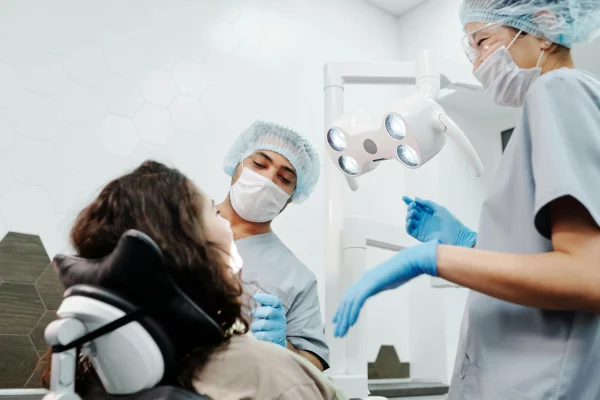Emergency dental exams serve as critical interventions when unforeseen oral health complications occur. Distinct from standard preventive checkups, which emphasize ongoing care and monitoring, these urgent appointments focus primarily on the immediate evaluation and management of acute dental issues. Situations such as intense pain, fractured teeth, dislodged fillings, or infections necessitate prompt professional assessment to mitigate discomfort and prevent escalation of the condition.
Timely response in these scenarios is essential; rapid diagnosis and treatment not only alleviate current symptoms but also reduce the likelihood of more extensive, invasive procedures in the future. In essence, seeking emergency dental care without delay can significantly influence the long-term prognosis of oral health.
What Are Emergency Dental Exams?
An emergency dental exams are focused, immediate evaluation performed when patients experience sudden dental issues that cannot wait for a regular appointment. The goal is to quickly identify the problem, manage pain, and begin appropriate treatment as soon as possible. Unlike routine checkups that emphasize prevention, emergency dental exams are reactive, zeroing in on problems like infections, trauma, or severe toothaches. Dentists performing these exams are trained to act swiftly, minimize discomfort, and stabilize your condition, often preventing more serious consequences.
Common Reasons for Emergency Dental Exams
Dental emergency exams rarely occur with advance notice, and their onset can necessitate immediate clinical intervention. Acute dental pain, for instance, may signal underlying infections or nerve involvement, both of which require urgent assessment to prevent escalation. Traumatic injuries such as avulsed (knocked-out) or fractured teeth demand rapid response to maximize the likelihood of successful reimplantation and minimize the risk of long-term complications.
Additionally, pronounced swelling, persistent bleeding, or the presence of abscesses generally indicates significant infection, which, if left untreated, has the potential to spread systemically. Damage to restorative dental work, including dislodged fillings, crowns, or bridges, also exposes vulnerable tooth structures, raising the likelihood of further decay or trauma. Even injuries involving the jaw warrant prompt evaluation to determine proper alignment and rule out fractures. Given that these conditions often arise unexpectedly, timely professional intervention is essential not only to alleviate pain but also to preserve oral health and reduce the need for more extensive treatments in the future.
What Qualifies as a Dental Emergency?
Minor sensitivity or a small chip in a tooth typically does not require immediate intervention and may be monitored for a short period. In contrast, true dental emergencies necessitate prompt professional attention. Indicators of urgent need include uncontrollable bleeding, severe or persistent pain unresponsive to over-the-counter analgesics, and swelling that compromises breathing, swallowing, or normal daily function. The presence of visible infection or abscess often characterized by pus and significant tenderness, signals a potentially serious condition that demands immediate care. Traumatic dental injuries, such as teeth that are loose, displaced, or avulsed, also require swift intervention to optimize the prognosis for tooth preservation. When in doubt, contacting a dental professional promptly is advisable to ensure appropriate evaluation and management.
Differences Between Routine and Dental Emergency Exams
Routine dental examinations are typically scheduled in advance and serve as a preventive measure, focusing on professional cleaning, detection of cavities, and the maintenance of long-term oral health. In contrast, emergency dental exams are unplanned and arise when immediate concerns or acute symptoms require urgent attention.
During an emergency assessment, the dentist’s immediate priority is to alleviate the patient’s discomfort and address the pressing issue. Once the acute problem is managed, more comprehensive dental care can be considered as part of the patient’s ongoing treatment plan.
When Should You Seek an Emergency Dentist?
If you’re experiencing intense dental pain, noticeable bleeding, facial swelling, or visible damage to your teeth or gums, it’s critical to seek emergency dental care immediately. Circumstances such as a knocked-out tooth, severe toothache, fractured or broken teeth, persistent bleeding, or any signs of infection like swelling or pus should be addressed without delay. Postponing professional evaluation in these cases can worsen symptoms and lead to more serious complications or expensive treatment down the line.
If you’re uncertain whether your condition qualifies as a dental emergency, it’s prudent to contact your dentist as soon as possible. Most dental offices can assess the urgency of your situation and advise you on appropriate next steps. Prompt attention often prevents further issues and promotes better health outcomes.
Severe Toothache or Infection
Persistent, sharp, or throbbing tooth pain that interferes with eating or sleeping often signals deeper problems such as decay reaching the nerve, a cracked tooth, or an infection. If left untreated, these issues can escalate, leading to abscesses or even systemic infection. Early intervention through an emergency dental exams allow for prompt treatment often saving the tooth and preventing further complications.
Broken, Chipped, or Knocked-Out Tooth
Dental trauma, whether resulting from sports, accidental falls, or everyday mishaps, poses significant risks to oral health. The urgency is particularly notable in cases of avulsed (knocked-out) teeth, where immediate re-implantation markedly increases the likelihood of successful preservation. Even seemingly minor fractures warrant prompt professional evaluation to mitigate the risk of further complications, such as infection or additional structural damage. Timely intervention remains essential in optimizing outcomes following dental injuries.
Swelling, Bleeding, or Abscess
Swelling, whether localized or spreading, often points to infection. An abscess can be particularly dangerous if bacteria enter the bloodstream. Uncontrolled bleeding after dental work or trauma also requires immediate care. Prompt emergency dental exams address these issues quickly, often preventing hospital visits or more invasive interventions.
What Happens During an Emergency Dental Exams?
During an emergency dental exams, the central objective is to swiftly identify the underlying cause of the patient’s discomfort and provide prompt relief. The dentist initiates the process by gathering a detailed account of the patient’s symptoms, relevant medical history, and circumstances surrounding the dental emergency. A comprehensive clinical assessment follows, including inspection of the teeth, gingiva, and adjacent oral structures. Diagnostic tools such as radiographs are frequently employed to uncover issues not immediately visible—such as fractures, infections, or other forms of pathology.
Once the etiology is determined, the dentist presents immediate management strategies tailored to the patient’s needs. These may involve analgesia, restoration of damaged teeth, incision and drainage of abscesses, or stabilization of mobile teeth. In certain situations, interim solutions are implemented to address acute symptoms, with a proposed plan for subsequent definitive care. Throughout this process, the practitioner remains attentive to both the patient’s immediate comfort and the preservation of long-term oral health.
Quick Evaluation and Pain Management
Upon arrival, the dental team promptly assesses your symptoms, reviews your medical background, and determines the severity of your condition. Addressing pain is typically prioritized, this may involve local anesthesia, medication, or, if necessary, draining an abscess to relieve pressure and discomfort. Once your pain is managed, the dentist works to stabilize your condition and minimize the risk of further complications. After you are comfortable and stable, a more comprehensive evaluation takes place, often including a visual examination and diagnostic imaging such as X-rays. These steps allow the dentist to accurately identify the underlying issue and formulate an appropriate treatment plan.
X-Rays and Diagnosis
Diagnostic imaging techniques, such as X-rays and 3D scans, play a crucial role in modern dental practice. These imaging tools provide clinicians with detailed visualizations of the oral structures, enabling them to detect issues like infections, fractures, impacted teeth, or underlying bone pathology—that are not apparent during a standard visual examination.
By supplying this critical information, diagnostic imaging allows practitioners to move beyond symptomatic treatment and instead address the underlying etiology of a patient’s complaint. As a result, interventions can be tailored to resolve not only the immediate symptoms but also the root cause, thereby supporting more effective and lasting patient outcomes.
Immediate Treatment Options
Emergency dental interventions vary considerably based on the patient’s particular condition. If an infection is present, antibiotics are often administered to control the spread and alleviate symptoms. In cases of deep infection or significant tooth damage, root canal therapy may be necessary to preserve the affected tooth. When a tooth is beyond saving, extraction becomes the most viable option to prevent further complications.
Temporary restorative measures such as crowns, fillings, or bonding are frequently applied to stabilize the affected area until a definitive solution can be implemented. For teeth that have become loose, splinting them to adjacent teeth provides needed support. Management of abscesses typically involves drainage, which serves to reduce swelling and eradicate infection.
Some interventions can provide immediate relief, while others are intended as interim steps before comprehensive treatment is completed. Ultimately, a dentist will formulate an individualized treatment plan, ensuring both effective healing and appropriate follow-up care for optimal outcomes.
Emergency Dental Exams Costs and Insurance Coverage
The cost associated with an emergency dental exams is subject to variation, largely influenced by the complexity of the dental issue and the interventions required. Typically, the basic fee for such an exam falls within the $100 to $300 range. However, when supplementary procedures such as diagnostic imaging, prescription of antibiotics, root canal therapy, or tooth extraction are necessary, the overall expense may increase substantially.
Dental insurance often mitigates these costs, particularly when the treatments are classified as medically necessary. Nevertheless, it is prudent for patients to consult their insurance provider to ascertain the specifics of their coverage, including copayment and deductible obligations. For individuals without dental insurance, numerous practices offer alternative financial arrangements. These may include flexible payment plans, third-party financing, or proprietary membership programs designed to enhance the affordability and accessibility of emergency dental care.
Typical Cost Range for Urgent Dental Visits
The expense associated with emergency dental exams fluctuates considerably, primarily influenced by geographic location, the underlying complexity of the dental issue, and the specific interventions required. Typically, the fee for an initial consultation and examination ranges from approximately $100 to $300. Radiographic imaging, such as X-rays, generally incurs an additional cost, varying between $25 and $150.
When therapeutic procedures are necessary, the associated costs may start at around $200 but can exceed $2,000, particularly for advanced treatments like root canals or dental extractions. Less intricate procedures, conversely, tend to remain at the lower end of the pricing spectrum. Overall, the financial burden of emergency dental care is highly variable and largely contingent upon both the severity of the presenting condition and the complexity of the required treatment.
Will Dental Insurance Cover Emergency Care?
Many dental insurance plans provide a degree of emergency coverage, typically encompassing diagnostic exams, X-rays, and some pain management. Coverage for more extensive procedures such as extractions, crowns, or root canals can vary substantially between policies. It is advisable to consult with your insurance provider in advance, if feasible, to clarify which services are covered. In urgent situations, dental offices often assist with benefit verification to help patients understand their coverage and potential out-of-pocket expenses.
Payment Plans and Financing Options
For individuals lacking dental insurance or possessing inadequate coverage, many dental practices provide various financing solutions. These options often include in-house payment plans, as well as arrangements through third-party financing organizations such as CareCredit or LendingClub. Additionally, patients may utilize health savings accounts (HSAs) or flexible spending accounts (FSAs) to manage dental expenses. These financial resources help ensure that necessary dental care remains accessible, even in situations where out-of-pocket costs might otherwise be prohibitive.
Finding an Emergency Dentist Near Me
In cases where dental emergencies occur unexpectedly—say, severe pain or sudden injury—it’s crucial to promptly locate a qualified dental professional. Begin by searching for local practices that specifically offer same-day or after-hours emergency appointments; many clinics clearly display these services on their websites. It’s also advisable to contact your primary dentist directly, as they often have established emergency protocols or can refer you to a trusted colleague. Reviewing patient feedback and verifying the dentist’s credentials can further ensure a high standard of care. Timely professional intervention can significantly reduce the risk of complications and help maintain optimal oral health.
What to Look for in Urgent Dental Clinics
When selecting an emergency dental provider, it’s critical to prioritize a practice with demonstrable experience in managing urgent dental issues, these are not situations for beginners. Ideally, the provider should utilize advanced diagnostic technology to ensure precise and timely care.
Equally important, seek transparency in pricing and flexible payment structures to avoid unexpected financial burdens during already stressful times. A compassionate, attentive staff trained in urgent care procedures is essential for both effective treatment and patient reassurance. Proactively identifying a reputable emergency dentist can substantially reduce response time and anxiety should a true emergency arise.
24/7 Availability and Same-Day Appointments
Dental emergencies rarely adhere to standard office hours. Fortunately, many urgent care dental providers recognize this reality and have implemented services such as 24-hour hotlines, same-day appointment availability, and coverage during weekends and holidays. The assurance that professional assistance is accessible at any hour provides considerable peace of mind when dental emergencies arise unexpectedly.
Frequently Asked Questions (FAQs)
1. When should I go to an emergency dentist?
Seek emergency dental care if you experience severe pain, significant swelling, uncontrolled bleeding, broken or knocked-out teeth, or signs of infection like fever, pus, or facial swelling. These symptoms can indicate serious underlying issues that require immediate professional attention. Delaying treatment may lead to more complex procedures, higher costs, or even permanent damage. Early intervention not only relieves discomfort but also helps preserve your teeth and overall oral health. When in doubt, it’s always safest to contact a dental professional promptly.
2. What happens during an emergency dental visit?
During your emergency visit, the dentist’s first priority is to stabilize your pain and manage any immediate symptoms. Once you’re comfortable, diagnostic tests like X-rays are performed to pinpoint the exact cause of the problem. If possible, the dentist will provide immediate treatment to address the issue and prevent further complications. In cases where full treatment can’t be completed during the initial visit, a detailed follow-up plan is created to ensure your condition is fully resolved. This comprehensive approach helps protect your oral health and minimizes the risk of future issues.
3. How much does an emergency dental exams cost?
Emergency dental visits typically start around $100 for the initial exam and basic diagnostics, such as X-rays or pain management. However, depending on the severity of the issue, the total cost can rise significantly. More complex treatments like root canals, extractions, crowns, or abscess drainage may range anywhere from $200 to $2,000 or more. Factors such as the location of the tooth, the complexity of the procedure, and the materials used can also influence the final price. It’s always best to consult your dental provider for a detailed estimate based on your specific needs.
4. Will my insurance cover emergency dental care?
Most dental insurance plans will cover at least a portion of the emergency dental exam and necessary diagnostics, such as X-rays and initial pain management. However, coverage for procedures like extractions, root canals, or crowns can vary depending on your individual policy, deductibles, and annual maximums. To avoid surprises, it’s always wise to verify your benefits ahead of time if possible. Many dental offices are experienced in handling insurance matters and can assist you in confirming coverage quickly, even during emergency situations. This helps ensure you receive the care you need without unnecessary financial stress.
5. Can I get treated on the same day?
In many cases, yes, dentists can often provide same-day treatment for common dental emergencies. Immediate care may include extractions, draining infections, prescribing antibiotics, or performing temporary repairs to stabilize damaged teeth. These prompt interventions help relieve pain and prevent the issue from worsening. However, more complex procedures, such as permanent restorations or extensive root canal therapy, may require additional follow-up visits to fully resolve the problem. Your dentist will create a personalized treatment plan to ensure both immediate relief and long-term oral health.
When dental emergencies happen, delaying care can make matters worse. Our skilled emergency dental team is ready to provide fast, compassionate care when you need it most. Don’t let pain or uncertainty hold you back, contact us immediately if you’re facing any sudden dental issue. We’ll guide you through every step, from rapid pain relief to comprehensive treatment solutions.


